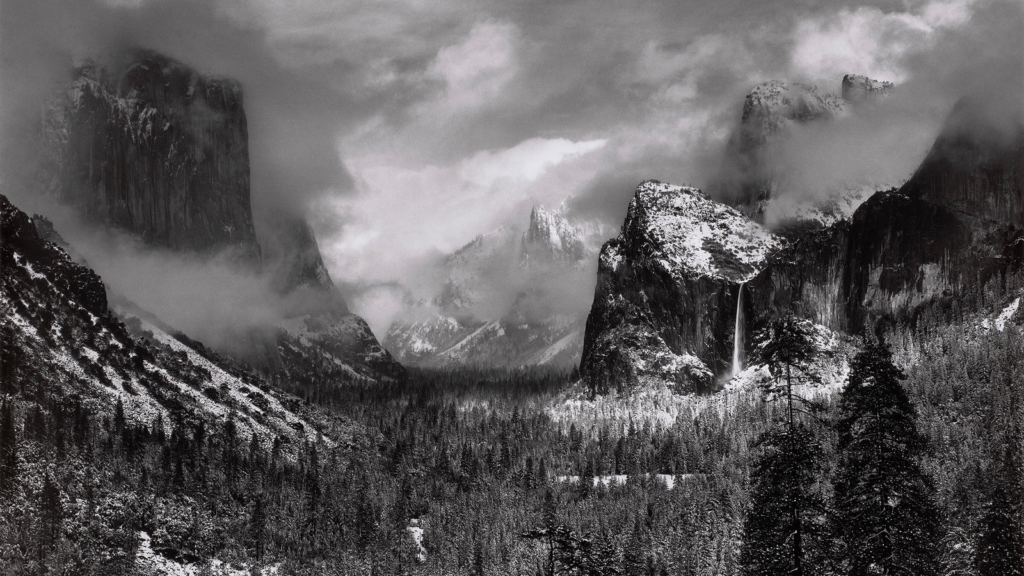Mood Board:






Ansel Easton Adams (February 20, 1902 – April 22, 1984) was an American landscape photographer and environmentalist known for his black-and-white images of the American West. He helped found Group f/64, an association of photographers advocating “pure” photography which favoured sharp focus and the use of the full tonal range of a photograph. With exquisite plays of light and dark, each gelatine silver photograph exhibits a moment captured by Ansel’s eye brought to life through his masterful touch.
Ansel’s photography has had great impact indeed, not only in awakening people to the beauty of nature but in inspiring many other photographers to turn their efforts to the natural scene and to use photography in the interests of environmental preservation.
Ansel Adams’ love of nature and his work in capturing vistas within the Sierras and other protected lands for all to see changed the American art world to include nature photography.
Adam’s background was quite challenging, therefore he took up photography as a distraction. When Adams was only four, an aftershock of the great earthquake and fire of 1906 threw him to the ground and badly broke his nose, distinctly marking him for life, also destroying his confidence growing up. He was not successful in the various schools to which his parents sent him; consequently, his father and aunt tutored him at home. While sick in bed with a cold one day at age 14, Ansel read a book that would eventually change his life. James Mason Hutchings’ In the Heart of the Sierras caught Adams’ imagination, and he soon managed to convince his parents to vacation in Yosemite National Park. From his first visit, Adams was transfixed and transformed. Equipped with a simple Kodak Box Brownie camera his parents gave him, he hiked, climbed, and explored, gaining self-esteem and self-confidence whilst snapping the first images of what would become a lifetime of incredible artistic productivity. He spent substantial time there, due to the love he had for the place, every year from 1916 to his death. In 1919 he joined the Sierra Club and then spent six summers accompanying High Sierra tour groups as trip photographer. The most important result of Adams’s somewhat solitary and unmistakably different childhood was the joy that he found in nature, as evidenced by his taking long walks in the still-wild reaches of the Golden Gate. Here, he developed a close bond with the nature around him, and began appreciating his surroundings and seeing the true beauty and potential in them.
Methodology:
“Weston is, in the real sense, one of the few creative artists of today. He has recreated the matter-forms and forces of nature; he has made these forms eloquent of the fundamental unity of the world. His work illuminates man’s inner journey toward perfection of the spirit.”

Visualisation:
Quoted by Ansel Adam’s Visualisation is “to see clearly in the mind prior to exposure, a continuous projection from composing the image through the final print”. Visualisation is the concept of being able to see the scene prior to shooting and using your mind to make the that scene as a final product. In addition to using visualisation, Ansel Adam’s alongside his fellow photographers in their group F/64 developed the ‘Zone System’.
The Zone System:

The zone system is a photographic technique for determining optimal film exposure and development. Adams described the Zone System as “not an invention of mine; it is a codification of the principles of sensitometry, worked out by Fred Archer and myself at the Art Centre School in Los Angeles, around 1939–40.”

Image analysis:

Adams commonly prioritised his photos based around the American West, in which he focused on features like mountains and rivers which can easily elevate an image. When taking these photos, Adams would adjust the camera settings to produce images that look completely different to how he saw them with his naked eye, in which he favours sharp focus and manipulates the camera settings to reach the photograph’s full potential and achieve a surreal outcome, often over-saturated with more details.
In this image in particular, Adams has clearly adjusted the ISO, shutter speed and aperture in order to emphasise the different tones and shades within the image. At the top he has included part of the sky in the angle, where the shades of grey are slightly darker around the outsides, and they get lighter towards the middle where the sun is being blocked. This is effective because from the angle of the photo, the brightness of the sky works well, with the peak of the mountains just in front, it successfully draws the viewers attention to the subject of the image. Adams has also incorporated lots of the river and trees in his image, which is effective because the tones of the trees contrast against the river, as they are very different. In my opinion, this photo looks better in black and white because it allows the lighter tones to appear brighter and the darker tones to appear more emphasised. We can also see where the sun has brightened up the river creating a reflection, which gives the overall outcome some life.
Overall, I like how Adams produces most of his outcomes in black and white as it differs from how we view things with the naked human eye, which makes each of his images more interesting. This also makes him unique to other artists. I like how he bases his photos around nature, it gives the effect that he is trying to send as message to his viewers, reminding them to appreciate their surroundings.
